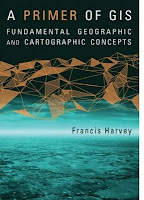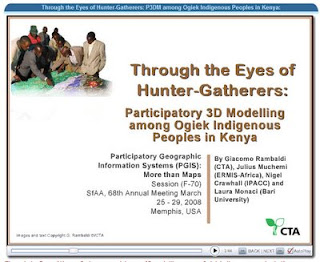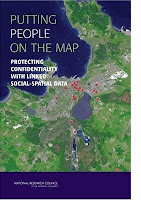
Tuesday, April 15, 2008
A Primer of GIS: Fundamental Geographic and Cartographic Concepts By Francis Harvey

Aboriginal Communities in Google Earth
Monday, April 14, 2008
Through the Eyes of Hunter-Gatherers: Participatory 3D Modelling among Ogiek Indigenous Peoples in Kenya

Sunday, April 13, 2008
Mapping is Power
Earth Island Institute’s Sacred Land Film Project
Monday, April 07, 2008
Geo-visualisation for participatory spatial planning in Europe
 The principle of public participation in policy-making and policy implementation features in many European Union directives and policy documents. It is also undeniably connected to the rise of what can be called the European e-society, in which digital technologies are expected to strengthen public involvement in democratic processes. One broad group of such technologies are commonly referred to as geo-visualisations.This book contains the results of a European project that explored the potential for using innovative geo-visualisation techniques in public participation processes for spatial planning. The approach taken in the project involved continual interaction between concept development, the technological possibilities, and their practical application in case studies conducted in Belgium, Poland, Portugal, Spain and the Netherlands. The structure of the book mirrors this procedure. Three chapters discuss the general concepts of spatial planning and participation, e-interaction, and innovation in organisations. Two chapters present the results of research into the communicative potential and the usability of 3-dimensional geo-visualisations. The translation of these concepts and findings into practice is reported in five chapters devoted to the case studies.The project generated greater understanding of the ways in which geo-visualisation can help to improve public participation in the process of finding solutions to spatial planning issues. This book and accompanying DVD with extra information, is therefore a valuable resource for professionals and practitioners already working with geo-visualisations in participatory spatial planning as well as those looking to do so. They can turn to this book for insights and inspiration.
The principle of public participation in policy-making and policy implementation features in many European Union directives and policy documents. It is also undeniably connected to the rise of what can be called the European e-society, in which digital technologies are expected to strengthen public involvement in democratic processes. One broad group of such technologies are commonly referred to as geo-visualisations.This book contains the results of a European project that explored the potential for using innovative geo-visualisation techniques in public participation processes for spatial planning. The approach taken in the project involved continual interaction between concept development, the technological possibilities, and their practical application in case studies conducted in Belgium, Poland, Portugal, Spain and the Netherlands. The structure of the book mirrors this procedure. Three chapters discuss the general concepts of spatial planning and participation, e-interaction, and innovation in organisations. Two chapters present the results of research into the communicative potential and the usability of 3-dimensional geo-visualisations. The translation of these concepts and findings into practice is reported in five chapters devoted to the case studies.The project generated greater understanding of the ways in which geo-visualisation can help to improve public participation in the process of finding solutions to spatial planning issues. This book and accompanying DVD with extra information, is therefore a valuable resource for professionals and practitioners already working with geo-visualisations in participatory spatial planning as well as those looking to do so. They can turn to this book for insights and inspiration.
Friday, April 04, 2008
2008 Indigenous Planning Conference "Leading Change: Blending Indigenous and Western Planning Tools" (1-3 October 2008, Anchorage, Alaska, USA)
The Leading Change conference (1-3 October 2008, Anchorage, Alaska, USA) is sponsored by the American Planning Association’s (APA) Alaska and Hawaii Chapters and the Indigenous Planning Division. The three-day conference will bring together planners, tribal leaders, and community members to share local experiences, planning tools and practices that reflect a commitment to honoring history, cultural identity, tradition, and land tenure. Conference participants will share stories from their own communities organized around general topic areas including land use and natural environment; governance, nation building and leadership; local control, community sustainability, and resilience; culture, education, and community services; economy; and infrastructure, public services, and facilities.
Putting People on the Map: Protecting Confidentiality with Linked Social-Spatial Data

At the same time, precise spatial data make it more likely that individuals can be identified, breaching the promise of confidentiality made when the data were collected.
Because norms of science and government agencies favor open access to all scientific data, the tension between the benefits of open access and the risks associated with potential breach of confidentiality pose significant challenges to researchers, research sponsors, scientific institutions, and data archivists. Putting People on the Map finds that several technical approaches for making data available while limiting risk have potential, but none is adequate on its own or in combination. This book offers recommendations for education, training, research, and practice to researchers, professional societies, federal agencies, institutional review boards, and data stewards.
Sunday, March 16, 2008
Difference between Google Maps and Google Earth
Google Earth Outreach
Sunday, February 24, 2008
An Atlas of Radical Cartography
Tuesday, February 12, 2008
Panel on Mapping Cultural and Biological Diversity; April 5-7, New York, USA
Remote Sensing and GIS Conference, May 5 - 6, 2008, Kupang, Indonesia
As part of Charles Darwin Universities AUSAID funded Public Service Linkages Program a GIS and Remote sensing Conference will be held at Nusa Cendana University in Kupang 5-6 May.
The conference will act as a forum to discuss the following: (i) current applications, projects and research in NTT using remote sensing and GIS technology; (ii) the development of formal and informal data and skill sharing networks; (iii) protocols for collecting and archiving data. A provincial wide conference is very important at this time when a range of regional initiatives are being developed to support good governance through data collection, archiving and analysis. The effecting sharing of capacity and aspirations within NTT will assist in the development of a coordinated approach in the development of spatial planning.
This is an advanced notice and call for presentations. It is proposed that presentations from the conference be published as proceedings. The organisers have currently identified the following broad topics:
- Critical land assessment in the Assesa catchment in Ngada
- Fire mapping and monitoring in Sumba
- Deforestation monitoring in Timor
- GIS for land capability assessment – development planning
- GIS for analysis of health and education data
- Community GIS and Participatory 3D Modeling (P3DM).
- Standards for data collection and storage
- Arrangements for data sharing
- Accuracy assessment
For further information you may contact: Dr. Marthen R. Pellokila (UNDANA) Email: rpellokila[at]yahoo.com and Rohan Fisher (CDU) Email: cycadmedia[at]bigpond.com
Saturday, January 12, 2008
Participatory 3D modelling applied also in the Sagarmatha National Park and World Heritage Site, Nepal.
Friday, January 11, 2008
New Social Cartography Project of the Amazon - Self-cartographing of people and tradicional communities
Cartographing research practices and self-cartographing help the affected social agents (marrons, indians, small farmers, settlers, fishermen, artisans, coal miners) to appropriate the results of these techniques and to guide their action of social and environmental changing. The meaning of affronting economical, environmental and political interventions that may interfere harmly on the life conditions, social and physical reproduction shows up the content of many actions.
The elaboration of the fascicles, the discussions and correlated activities (researching, identifying, codifying, mapping, cartographing) correspond to the positions and interests of the agents who formulate these activities and all this results in an appropriation of knowledge by those who produced it.
Project coordinators: Alfredo Wagner Berno de Almeida (Universidade Federal do Amazonas, Manaus, Brazil) and Rosa E. Acevedo Marin (Universidade Federal do Pará, Núcleo de Altos Estudos Amazônicos, Belém, Brazil)
Wednesday, January 02, 2008
Volunteered geographic information
Reference: Goodchild MF (2007). Citizens as sensors: the world of volunteered geography. GeoJournal (DOI 10.1007/s10708-007-9111-y)
Position paper presented by Dr. Goodchild at the Workshop on Volunteered Geographic Information, December 13-14, 2007, Santa Barbara, California, USA
All papers presented at the workshop are available via this link
Saturday, December 08, 2007
Dr. Nigel Crawhall, director of the Indigenous Peoples of Africa Coordinating Committee (IPACC) thoughts about P3DM
Saturday, December 01, 2007
Locating Participatory 3D Models on Earth
View Larger Map
